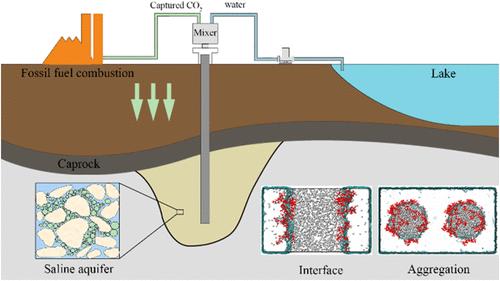聚丙烯酰胺亲水性链对纳米乳化碳地质固存的微观机理研究
IF 7.3
1区 化学
Q1 CHEMISTRY, MULTIDISCIPLINARY
引用次数: 0
摘要
温室气体的大量排放凸显了推进碳捕获、利用和封存技术研究的迫切需要。纳米乳液已经成为解决地质封存过程中二氧化碳羽流迁移等因素带来的安全挑战的一种有前途的方法。延长纳米乳的寿命可以显著提高碳储存的效率和安全性。采用分子动力学模拟方法研究了表面活性剂对超临界二氧化碳纳米乳及其界面的影响。结果表明,含有三硅氧烷疏水基团和聚丙烯酰胺亲水性链的表面活性剂表现出协同作用,显著提高了纳米乳的稳定性。此外,在表面活性剂组分中,丙烯酰胺基团是缔合过程中最重要的贡献者。表面活性剂PA5使纳米乳液的自聚集率降低到13.00%,并将纳米乳液的聚集时间从未添加表面活性剂的对照组的11.32 ns延长到81.16 ns。稳定性的增强是由于PA5在亲水性和CO2亲和性之间取得了最佳平衡,并且在纳米乳液表面结合效率高,稳定性好。PA5作为一种高性能表面活性剂,在CCUS技术中应用前景广阔。本文章由计算机程序翻译,如有差异,请以英文原文为准。

Microscopic Mechanism of the Polyacrylamide Hydrophilic Chain on Nanoemulsion-Based Carbon Geological Sequestration
The large emission of greenhouse gases has underscored the critical need for advancing research on carbon capture, utilization, and storage (CCUS) technology. Nanoemulsions have emerged as a promising approach to addressing safety challenges posed by factors such as CO2 plume migration during carbon geological sequestration. Prolonging the lifetime of nanoemulsions can significantly enhance both the efficiency and the security of carbon storage. The effects of surfactants on supercritical carbon dioxide (sCO2) nanoemulsions and the sCO2–H2O interface are investigated using molecular dynamics simulations. It is revealed that surfactants incorporating trisiloxane hydrophobic groups and polyacrylamide hydrophilic chains exhibited a synergistic interaction, substantially improving the stability of nanoemulsions. Moreover, the acrylamide group is identified as the most significant contributor during the association process among the surfactant components. The PA5 surfactant reduced the self-aggregation rate to 13.00% and extended the nanoemulsion aggregation time from 11.32 ns (control group without surfactants) to 81.16 ns. The enhancement in stability is attributed to PA5 achieving an optimal balance between hydrophilicity and CO2 affinity and binding at the nanoemulsion surface with efficiency and stability. PA5 holds great promise as a high-performance surfactant for applications in CCUS technology.
求助全文
通过发布文献求助,成功后即可免费获取论文全文。
去求助
来源期刊

ACS Sustainable Chemistry & Engineering
CHEMISTRY, MULTIDISCIPLINARY-ENGINEERING, CHEMICAL
CiteScore
13.80
自引率
4.80%
发文量
1470
审稿时长
1.7 months
期刊介绍:
ACS Sustainable Chemistry & Engineering is a prestigious weekly peer-reviewed scientific journal published by the American Chemical Society. Dedicated to advancing the principles of green chemistry and green engineering, it covers a wide array of research topics including green chemistry, green engineering, biomass, alternative energy, and life cycle assessment.
The journal welcomes submissions in various formats, including Letters, Articles, Features, and Perspectives (Reviews), that address the challenges of sustainability in the chemical enterprise and contribute to the advancement of sustainable practices. Join us in shaping the future of sustainable chemistry and engineering.
 求助内容:
求助内容: 应助结果提醒方式:
应助结果提醒方式:


